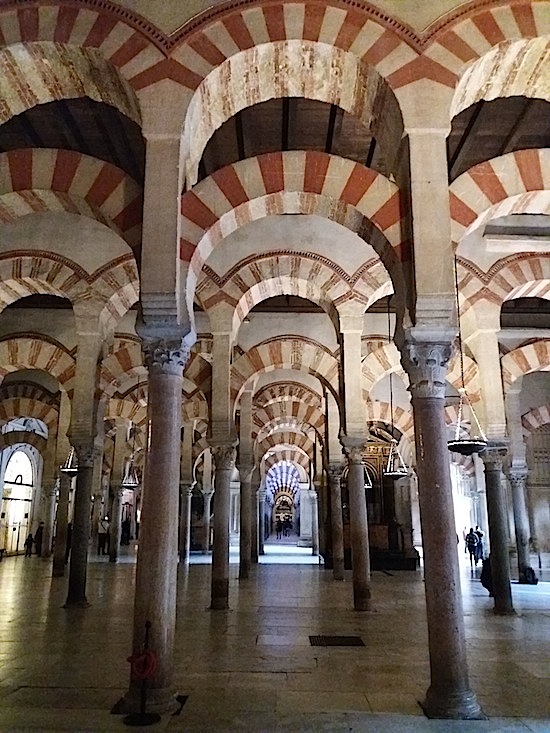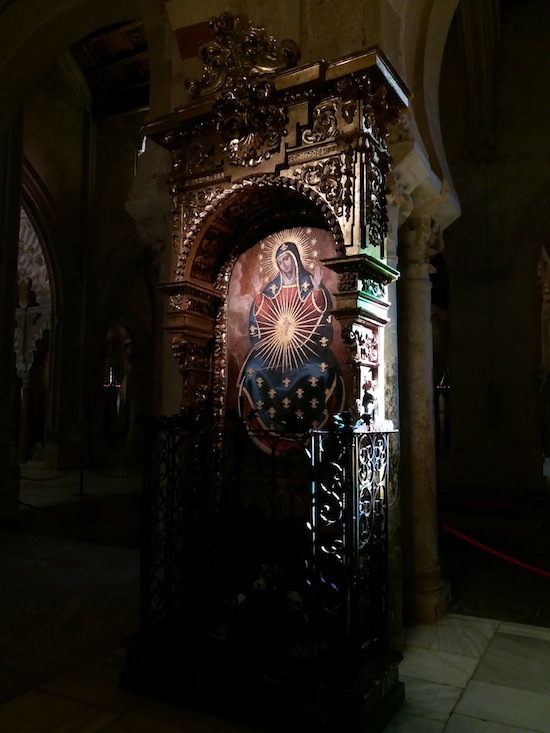The Mosque-Cathedral of Córdoba, Spain

The mosque interior, showing the famous series of double arches.
The column on the left has a Corinthian capital reused from a
Roman building. The one of the right has a Moorish capital.
I am fortunate to live in a country that has preserved remains from a wide variety of civilizations. From Roman cities to medieval castles, Spain’s got it all. One culture that has left an enduring legacy on Spanish architecture, cuisine, and language is that of the Moors. For much of the Middle Ages, large portions of the Iberian Peninsula were ruled by Muslims from North Africa and the Levant, who built one of the country’s most beautiful buildings.
Invading Muslims took Córdoba, then a rather minor Visigothic city in southern Spain, in 711 AD. They destroyed most of it but spared the church, which was then divided and used as a house of worship for both faiths. The city languished until the arrival of Abd al-Rahman I in 756, who took power in Muslim Spain and made Córdoba his capital. In 784 AD he ordered a great mosque to be built on the site of the church. Later Muslim rulers expanded it until 1236, when Córdoba was recaptured by the Christians and the building was converted into La Catedral de Nuestra Señora de la Asunción (The Cathedral of Our Lady of the Assumption).
The result is an amazing hybrid of various periods of Moorish and Christian architecture.

The mosque-cathedral from the air.
Photo courtesy Toni Castillo Quero via Wikimedia Commons
Córdoba was the center of Al-Andalus, and the mosque was the center of Córdoba. Thus Abd al-Rahman and his successor spared no expense. Artisans were imported from all corners of the Islamic world, and only the finest materials were used. Its most impressive feature is the hypostyle hall, pictured above, with a total of 856 columns of jasper, onyx, marble, granite, and porphyry. Most of these columns were looted from various Roman buildings, including a pagan temple thought to have been on or near the site. Since the columns were too short for the high ceiling the designers wished to have, they developed a double arch, with a semicircular arch buttressed by a lower horseshoe arch.
Within the mosque compound is the Court of Oranges, a garden filled with orange trees, plus a large central fountain that caught the breeze and cooled the area. During a hot day in the Spanish sun, it’s a relaxing place to linger.
Córdoba was one of the world’s great cities at this time. Historians estimate that in the year 1000 it had a population of 100,000. Its craftsmen made silks, jewelry, and leather work that sold across Europe, and the city had numerous palaces, schools, and gardens.

The Christians later added a Gothic ceiling to the hypostele hall
When Córdoba once again fell into Christian hands, the mosque inevitably became a church. Fortunately, the Spanish Christians were just as entranced by the building as the Muslims, and preserved large portions of it. Chapels were added in the great prayer hall, obscuring some of the view, and the rectangular, Moorish-style minaret was converted into a bell tower.

The gilded miqrab points worshipers in the direction
of Mecca. Oddly, the miqrab points south although in
reality Mecca is to the east-southeast
While this building is what makes Córdoba justly famous, there’s plenty more to see in town. We’ll check out the rest of it next week.
Photos copyright Sean McLachlan. More below!
Sean McLachlan is the author of the historical fantasy novel A Fine Likeness, set in Civil War Missouri, and several other titles. Find out more about him on his blog and Amazon author’s page. His latest book, Tangier Bank Heist, is a noir mystery set in the International Zone of Tangier in the 1950s.

A curious variation of the double arch next to the miqrab

A Christian chapel inside the mosque


One of the gates into the mosque, with a view of the Court of Oranges.
Note the medieval escutcheons placed over the Islamic scroll work

The outer wall of the mosque, with the minaret converted into a bell tower

A view of the minaret/bell tower from inside the courtyard
In the collection Aurora in Four Voices, Catherine Asaro has an essay in which she discussed applying Fourier analysis to the arches in the Great Mosque of Cordoba and related it to her story “The Spacetime Pool.”